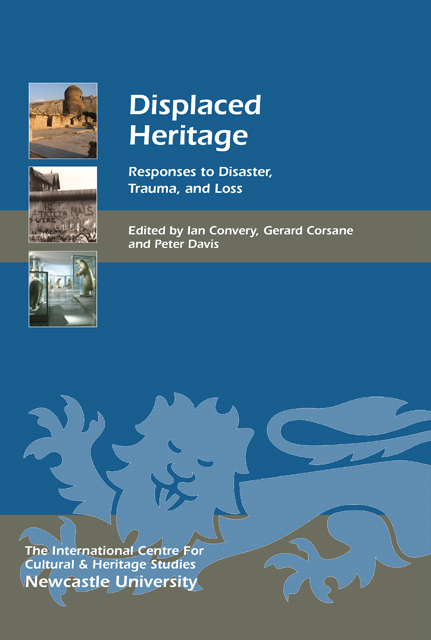Book contents
- Frontmatter
- Contents
- List of Illustrations
- Acknowledgments
- List of Abbreviations
- Preface
- Introduction
- Displaced Heritage: Histories and Tourism
- Displaced Heritage: Trauma, Confinement and Loss
- Displaced Heritage: Lived Realities, Local Experiences
- Displaced Natural Heritage
- Endpiece
- List of Contributors
- Index
- Heritage Matters
17 - Reading Local Responses to Large Dams in South-east Turkey
Published online by Cambridge University Press: 24 February 2023
- Frontmatter
- Contents
- List of Illustrations
- Acknowledgments
- List of Abbreviations
- Preface
- Introduction
- Displaced Heritage: Histories and Tourism
- Displaced Heritage: Trauma, Confinement and Loss
- Displaced Heritage: Lived Realities, Local Experiences
- Displaced Natural Heritage
- Endpiece
- List of Contributors
- Index
- Heritage Matters
Summary
Introduction
Development interventions to transform natural resources often involve displacement in some form (WCD 2000, 102); in the case of large dams and their related infrastructure, this has led to people’s physical dislocation, livelihood deprivation and loss of access to cultural resources and heritage as river basins around the world are significantly, and often irreversibly, altered. The adverse socio-cultural impacts for the often involuntarily and coercively displaced – significant globally in magnitude, extent and complexity – warrant detailed deliberation when decisions are made to construct large dams, and yet they are still often not acknowledged in the planning process and can remain unrecognised during project operations (ibid, 98). In south-east Turkey, where ambitious hydro-development of the Tigris and Euphrates basins is ongoing under the Southeastern Anatolia Project (Turkish acronym GAP), fundamental omissions regarding cultural heritage impacts have coalesced around the relationship between affected communities and their cultural resources as local-scale concerns and interests are inadequately understood, often misprized and largely excluded from programmes that collapse cultural heritage aspects into limited archaeological salvage work.
The Ilisu Hydroelectric Dam, currently under construction on the River Tigris and scheduled for completion in 2014, is a controversial example of the persistent failure of developers and state officials to adequately consult with local people on their impacted cultural resources. In the case of perhaps the most important of hundreds of cultural and historical sites at risk of inundation by the Ilisu reservoir – Hasankeyf – residents have not officially been ‘asked to explain which sites form a central core to their identities or how the loss or preservation of certain sites will influence their cultural well-being... [or] to assess the impact on their way of life by the loss of their heritage landscape’ (Schmidt 2000, 14), leaving environmental impact assessment reports (eg Hydro Concepts et al 2005) and cultural heritage action plans (eg Ilisu Consortium 2006) devoid of meaningful significance assessment data. Understanding significance, particularly as it pertains to social value – a concept that ‘embraces the qualities for which a place has become a focus of spiritual, political, national or other cultural sentiment to a majority or minority group’ (Australia ICOMOS 1999, 12) – is often central to arguments for conserving a place and its liminal positioning for Hasankeyf requires urgent critical attention.
- Type
- Chapter
- Information
- Displaced HeritageResponses to Disaster, Trauma, and Loss, pp. 187 - 198Publisher: Boydell & BrewerPrint publication year: 2014



